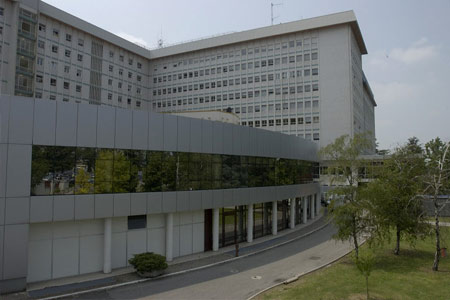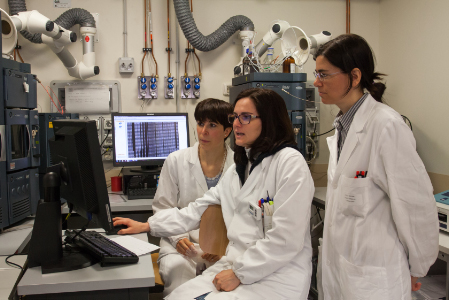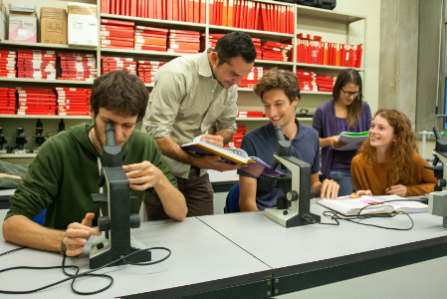The maintenance of a constant cell volume in relation to changes in intracellular/extracellular osmolarity is a very important stimulus and it is a peculiar characteristic of different cell types. The large part of the eukariotic cells responds to increase or decrease cell volume throughout the activation of metabolic pathways or cell membrane cation transport systems which bring the cells back to their original volume and to the resting state. These processes are part of the normal cell function. Most of the membrane cation transport pathways are ubiquitarious, thus the red cells may represent an excellent model for the characterization of their function and the application of other eukariotic cells. In the last decade, our Research Unit has largely contributed to the characterization of some of the membrane cation transport pathways, such as the K-Cl cotransport, and the Gardos channel.
The membrane cation transport pathways which are responsible for red cell cation homeostasis, may be divided into three groups according to their functional characteristics: the energy dependent system like the Na-K ATP dependent pump, the gradient driven systems like the K-Cl cotransport and the membrane channels like the Ca2+ activated K+ channel, known as the Gardos channel, and the voltage dependent channel.
Abnormal function of the red cell membrane cation transport pathways and/or ion channels has been described in hereditary diseases of erythrocytes due to mutation of hemoglobin chain(s), to red cell membrane defects or to red cell enzymes' defects.
Hereditary disease of hemoglobin chains: Sickle cell disease (HbS) is characterized by dehydrated red cells which are the results of abnormal function of red cell membrane cation transport pathways. In sickle cell disease the K-Cl cotransport is abnormally activated, in association with an abnormal function of the Gardos channel. The concerted action of these systems is responsible for water and K loss. The dehydrated red cells containing polymers of HbS, play a crucial role in the pathogenesis of the vaso-occlusive crisis and of the ischemic organ damages, characterizing sickle cell disease. Our Research Unit has largely contributed to the characterization of the function of K-Cl cotransport both in human sickle red cells and in erythrocytes of transgenic mouse model for sickle cell disease. Recently, the genetic sequence of the family of Na-Cl protein transporter, which K-Cl cotransport (KCC1) and Na-K-2Cl cotransport are part of, has driven the investigators to hypothesize the function of different protein regions, like the potential phosphorylable/dephosphorylable sites; the proteomic approach may identify the phosphorylate/dephosphorylate sites by certain. The cross-talk between the protein transporter and the phosphatases/kinases has been recently shown in red cells of mouse knockout for two tyrosine kinases of the Src family: Fgr and Hck, where the K-Cl cotransport is abnormally activated. In another mouse model (MGH/MGL) we have shown the cross-talk, in the regulation of K-Cl cotransport, between Fg/Hck and at least one of the isoform of the serin-threonine phosphatase of PP-1 family: PP-1 alpha.
The data collected until now are preliminary and limited by the use of in vitro inhibitors/activators of family of phosphatases/kinases which can act with more than one target at the same time. Thus, the traditional approach does not permit to study t6he cross-talk structure/function between transport protein/ion channel and eligible phosphatases/kinases which may regulate them.
Hereditary diseases of red cell membrane: The red cell membrane cation transport pathways have been described to be altered in hereditary diseases of red cell membrane like the hereditary stomatocytosis, the spherocytosis and the acanthocytosis. In these diseases it has also been observed an abnormal function of the anion exchager and/or the Gardos channel. The anion exchanger, localized in the band 3, plays a crucial role in the regulation of the red cell volume. The data collected until now are mainly descriptive and this approach do not permit to find the correlation between abnormal function of the transport systems and the protein structure. Now, the role of the membrane cation transport systems in rearrangement of red cell cytoskeleton need to be studied and characterized first in normal red cells and then in the diseased erythrocytes. The proteomic approach may allow to associate the abnormal function of a membrane cation transport pathway/ ion channel and the phenotype of the protein transporter.
Our Research Unit has the techniques for studying and characterizing the function of the main membrane cation transport pathways and the Gardos channel in mature circulating red cells and in erythroid precursors using Na and K in/efflux, with the use of radioactive tracers, too. Using imunoblotting tecnique and enzymatic assays on imunoprecipitates with specific antibodies, we can evaluate the expression and function of some of the tyrosine-kinases of the Src family and of some of the serin-threonin isoform of the PP-1 family which recently we have described to be involved in the regulation of the K-Cl cotransport activity. Moreover, the availability in our laboratory of mouse models for sickle cell disease, beta thalassemia as well as mouse strains knockout for tyrosine kinases of the Src family or for tyrosine phosphatases (PTP?), might permit to identify protein targets which play crucial roles in diseased red cells. The study of the function of some of these phosphatases/kinases might be further developed in collaboration with the Department of Biochemistry, University of Padova, which may support us in the characterization of the protein substrates and in the enzymatic kinetics.
Whenever need, our Rsearch Unit can further study the function of a protein transporter in transfected oocytes of Xenopus laevis, which peculiarity is the absence of volume regulator transport systems, except for the N-K-2Cl cotransport.Using this technique we have already characterized the activity of murine K-Cl cotransport and the different factors modulating it.
The proteomic approach might be used in the characterization of the structure of the protein transporters ( cation transports and/or ion channel), in the identification of the relationship protein/protein and in the characterization of the cascade activation/resting of the membrane transport systems. The acquirement of these data might be used for developing new and fast methods of diagnosis and for identifying pharmacological targets and for developing new therapeutic strategies.







